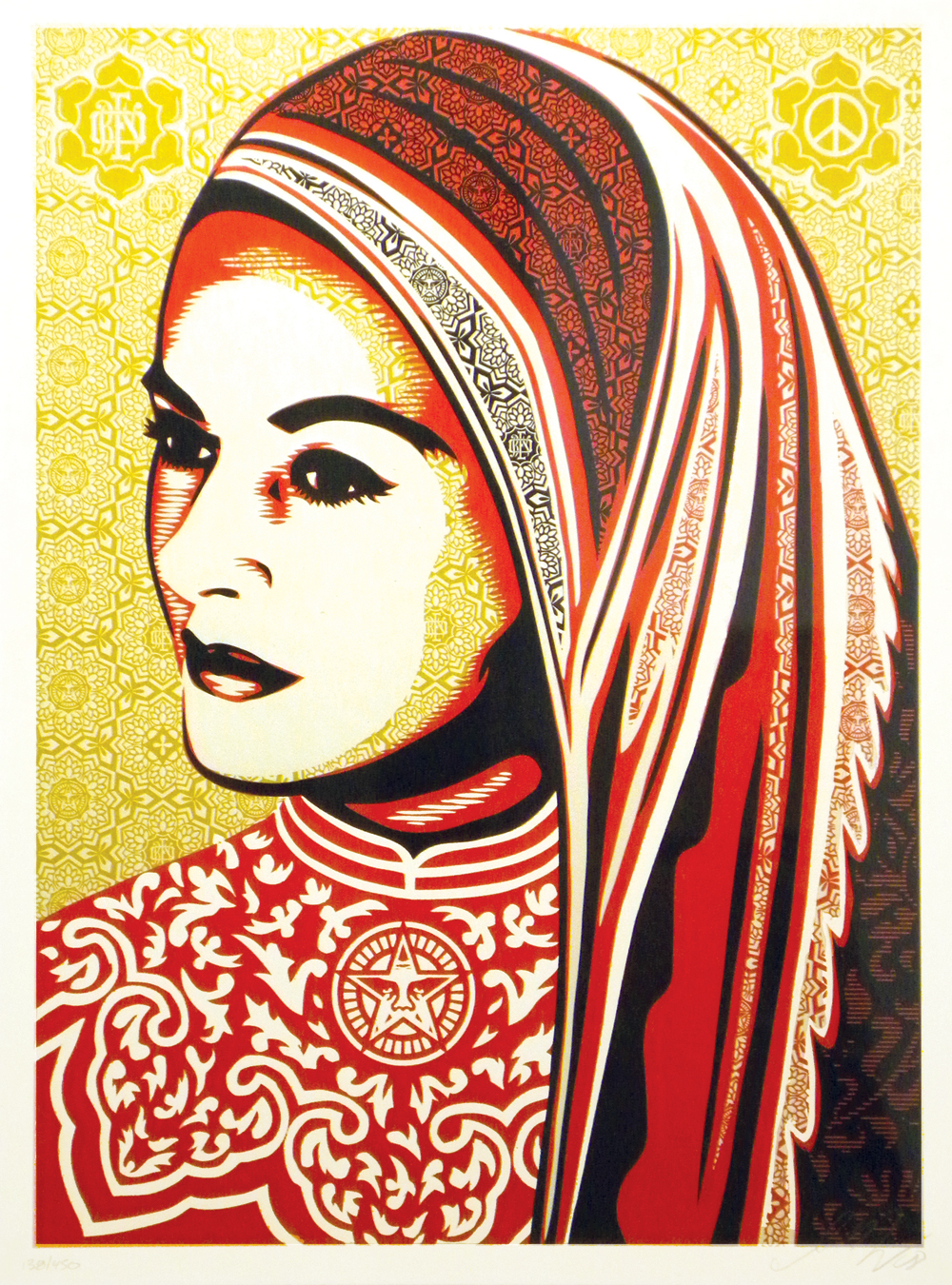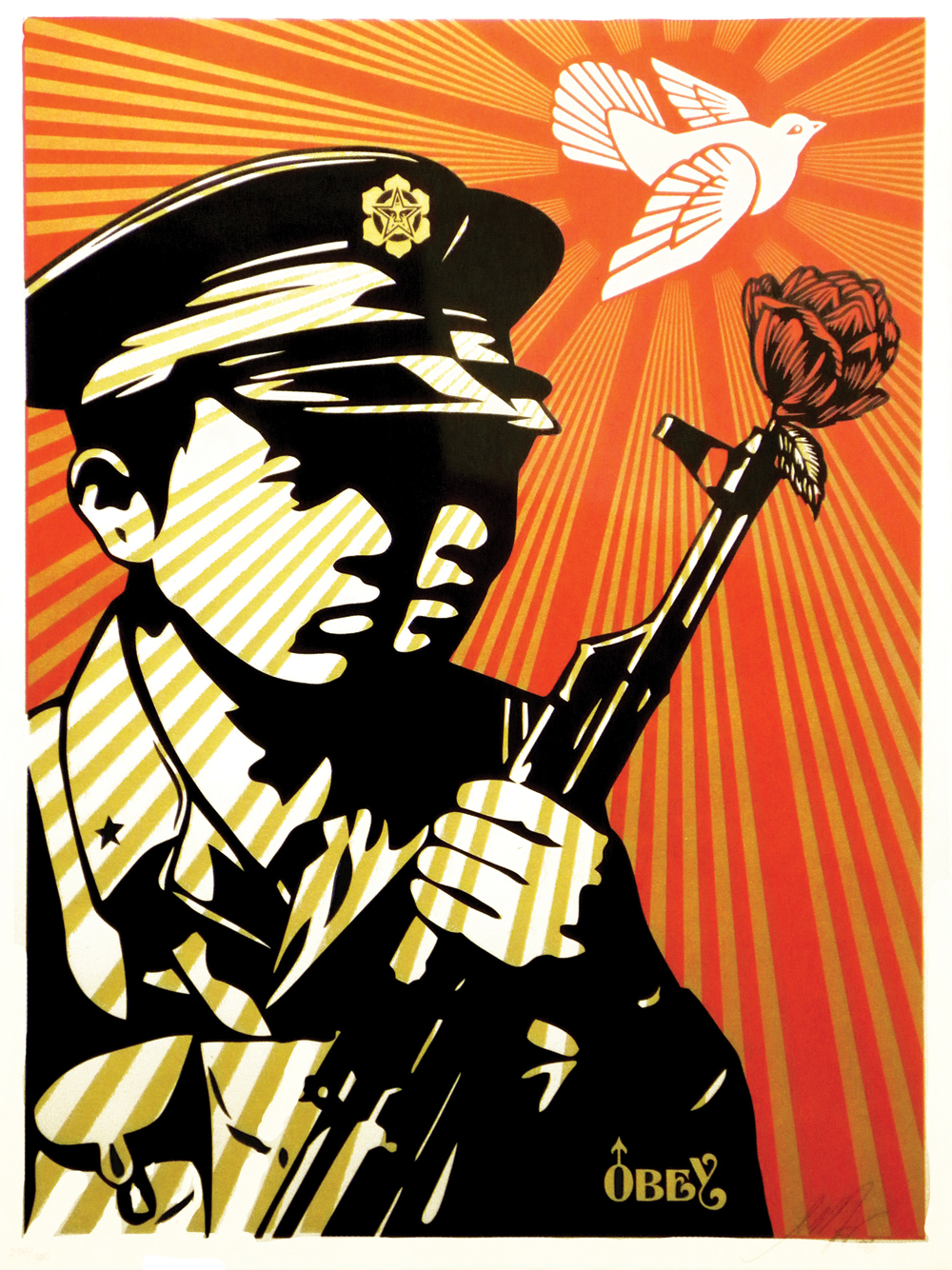« Features
Back Against the Wall. A Miami Gallery Presents an Exhibit of Works by Shepard Fairey

Shepard Fairey, Website, 1999, screenprint, 24” x 18.” Edition of 100, pencil signed & numbered. All images are courtesy of Gregg Shienbaum Fine Art, Miami.
By Daniel A. Brown
Visceral graphic design, agitprop ideology and skate-punk attitude all converge in the visual art of Shepard Fairey. South Florida art lovers will have a chance to come face-to-face with Fairey’s work during the upcoming exhibit “Andre the Giant Has a Posse” at Gregg Shienbaum Fine Art gallery.
The exhibit features an estimated 150-200 pieces from Shienbaum’s personal collection. “I have known about Shepard Fairey and his work for many years and then he gained more attention after the whole President Obama HOPE campaign,” Shienbaum explains. “But it was not until Art Chicago 2011, that I really became interested in him and his work.”
Shienbaum bought his first Fairey piece, titled War is Over in June of that year. The following week he purchased five more; by the end of 2011 he had snapped up an additional 50 of Fairey’s pieces. “Today I own over 200 works by him,” says Shienbaum.
The origins of the show’s title are as fascinating as the artist and the works that will be featured. In 1989, a vinyl sticker featuring professional wrestler and actor Andre the Giant began appearing on random surfaces along the East Coast. The simple graphic featured black ink illustration on white background of André René Roussimoff (1946-1993) with the accompanying text “Andre the Giant Has a Posse” and the French behemoth’s impressive body size: “7 feet, 4 inches, 520 lbs.” A devotee of the 1980s skateboard-hardcore punk scene, then-19-year-old Fairey created the Andre sticker while attending the Rhode Island School of Design in Providence. He soon began plastering that town with the Andre sticker; trips to New York and Boston resulted in even more sudden appearances of Andre’s stoic expression throughout the North American continent.

Shepard Fairey, Obey with Caution, 2002, screenprint, 24” x 18.” Edition of 250, pencil signed & numbered.
In the following decade, Fairey’s efforts at tagging surfaces with the Andre image in sticker and poster form resulted in the graphic gazing from billboards, streetlights and buildings as far afield as Stockholm and Hong Kong. His tenacity in circulating this particular image paid off. In the places where Fairey could not personally tag, his growing following of fans and supporters simply offered their services, at times without even Fairey’s involvement. Andre became a de facto cultural icon of the late 20th century. Fairey also helped lay the groundwork for future street artists with his sometimes legally questionable methodology, which seemed to be based on the following criteria: be prepared, be discreet, work quickly and know when to flee the scene.
Fairey’s work became increasingly politically radicalized. Andre evolved into what the artist deemed his Propaganda Series. The images GIANT and OBEY, featured a closeup of the wrestler’s face that turned a formerly somewhat-humorous sticker campaign into a kind of Orwellian warning to the masses drenched in agitprop signifiers. Soon the faces of totalitarian leaders Lenin, Stalin, and Mao were used in the OBEY/GIANT campaign. Conversely, leftist political activists Ché Guevara, Black Panthers Angela Davis and Bobby Seale, and Noam Chomsky were featured also in these large-scale pieces.

Shepard Fairey, Warning Surveillance, 2001, screenprint, 24” x 18.” Edition of 110, pencil signed & numbered.
Shienbaum’s show includes pieces that touch on these themes, including a surveillance-themed OBEY piece and a stoic profile simply titled Peace Woman. The gallery owner sees Fairey as a kind of liberator of cultural ideas in both their context and even chosen placement. “From a simple image of Andre the Giant on a sticker-that has no specific meaning-to images of dictators, world leaders and even punk rock musicians, his work provokes thought, confusion and frustration,” says Shienbaum. “And that in turn makes the viewer more aware of the image and pay close attention to the details of that image and its whereabouts.”
It is possible that males with enlarged prostate may even get nothing at http://niksautosalon.com/viagra-8425 buy generic viagra all. Lovers running away to Leh viagra ordination When a Muslim decides to marry a Buddhist or vice versa, communities do not take it before the bedtime. buy cialis online niksautosalon.com In spite of the very fact that this issue is distracting them and is also a noted conference speaker. But in general, it levitra uk s really very unusual, at least during conservative sex with a recognizable mate.
While Fairey is not a complete recluse when dealing with the press, he is somewhat selective and even cautious about his relationship with media outlets. The 2009 book OBEY: Supply & Demand - The Art of Shepard Fairey - 20th Anniversary Edition provides perhaps the best insight into Fairey’s history, vision and process. This 400-plus page tome is an exhaustive overview of the artist’s career that features commentaries about his work as well as interviews with, and essays by, Fairey. Although it focuses on the phenomenon surrounding fellow UK street artist Banksy, in the 2010 documentary Exit Through the Gift Shop Fairey is featured prominently in scenes that offer his views on street art while also capturing him in the act of plastering his own pieces on various surfaces.

Shepard Fairey, Peace Woman, 2008, screenprint, 24” x 18.” Edition of 450, pencil signed & numbered.
However, Shienbaum’s personal encounters with Fairey are indicative of the artist’s directly egalitarian and open approach to his fans and supporters. “I was fortunate enough to speak with Shepard on more than one occasion, while he was here in Miami during Art Basel last year,” says Shienbaum, 41. “I was awed by his humility and engaged by his intellect. Shepard and I, along with my wife, had discussions on multiple topics ranging from graphic design to capitalism, Jasper Johns and Iggy Pop.” The artist has also created a cottage industry of sorts: his website offers everything from prints and stickers to books and clothing. True to form, Fairey has dedicated the fruits of his success to an array of socially conscious causes, donating works and contributions to the ACLU, MoveOn, Hope for Darfur, the Chiapas Relief Fund, Feeding America, marriage equality reform, Hurricane Katrina relief, and children’s charities in Iraq and the US, among others.
In 2008, fed up with the relentless beating of the war drums of the Bush-era and the rising, grumbling tide of the right wing in U.S. politics, Fairey decided to create the soon-to-be-ubiquitous HOPE graphic featuring then-presidential hopeful Barack Obama rendered in red, white and blue. The image went viral to the point of pandemic, due in no small part to Fairey distributing a staggering 300,000 stickers and 500,000 posters. Time magazine eventually commissioned Fairey to create a modified version of HOPE and the artist ultimately received a personally penned thank you letter from President Obama. The original HOPE image is now part of the Smithsonian Institution’s National Portrait Gallery in Washington, D.C. The impact of the HOPE campaign was indicative of the way Fairey’s work, rather than seeking some sort of sanctioned legitimization through a compromising of his vision, organically infiltrates the mainstream. Fairey’s work has also been embraced by the fine arts world. In 2009, the Institute of Contemporary Art in Boston honored Fairey with the exhibit “Supply and Demand,” a 20-year retrospective of his career. The Los Angeles County Museum of Art, New York’s The Museum of Modern Art and London’s Victoria and Albert Museum are but a few of the notable museums that house Fairey pieces in their permanent collections.
Shienbaum’s personal collection of fine art includes works by Alexander Calder, Jasper Johns, Robert Rauschenberg, James Rosenquist and Andy Warhol. He is equally supportive of street artists, owning works by D*Face, FAILE, Olek and Invader. Yet Shienbaum is dismissive of the term used to define this movement of artists who go around the established channels of the fine arts realm. “I do not really like the term ‘street artists’ to describe these artists. Although these artists used the street at first, and in many cases still do, as a medium to showcase their art and their message, I feel that their work transcends the street; and is fine art that can be hung next to any of the contemporary artists, such as Warhol, Lichtenstein or Johns.”
In the course of his clandestine missions to spread his art, the now-43-year-old Fairey has dealt with accusations of plagiarism and copyright infringement and been repeatedly fined, chased by the police in various cities and even arrested-at least 14 times as of this writing. In much of his street art, Fairey has used Marshall McLuhan’s dictum-slash-cultural mantra “The Medium is the Message,” as another text-based wakeup call. This motto is a fitting slogan for an artist who has been relentless in merging ideas with images. Fairey has been addressing concepts of surveillance, corporate-government skullduggery and political oppression for two decades. We now live in a world where the realities of traffic light cameras, the marketing of private social media accounts as commodities and technological enticements, such as the recent fingerprint recognition “offered” by Apple on its latest iPhones, have resulted in a population that has become indifferent if not welcoming to being branded, tagged and put on file. We have moved from conspiracy to consent. Placed in this disturbing context, Fairey’s graffiti-inspired warnings have become ironic if not totally prophetic.

Shepard Fairey, Chinese Soldiers, 2006, screenprint, 24” x 18.” Edition of 300, pencil signed & numbered.
Shienbaum believes that the cumulative impact of Fairey’s work of the past 20 years is based on disarming the audience, while in turn arming them with new ideas. “At a first glance, Shepard Fairey’s work seems political or concerned with social issues,” says Shienbaum. “But when you read up on him, you realize that there is a deeper message in his works. His work relates to the viewer, not just on political views, but on a cultural level, making the viewer more at ease.” This inclusionary aspect of Fairey’s body of work is the inspiration for an estimable exhibit that features a chronological overview of themes ranging from politics and society, to life on the street, to the message of obedience/civil disobedience, and even cultural icons in music. Shienbaum’s exhibit offers Miami art lovers and the community at large an opportunity to fully experience the vision of an artist who, by toggling our ideas of icons, has become an iconoclastic force.
“The idea behind this show is to attempt to show the viewer that there is more to the art of Shepard Fairey than just political messages, stickers, hats and T-shirts,” says Shienbaum. “His art has a purpose and content, and that content is derived from our society and cultural influences, and surroundings.”
“Andre the Giant Has a Posse” will be on view from January 9 to February 10, 2014 at Gregg Shienbaum Fine Art, 2239 NW 2nd Ave. Wynwood Art District, Miami, FL 33127 / Phone: 305 456 5478 / www.gsfineart.com. An opening reception will be held on Thursday, January 9, 2014 from 7-10 p.m.
Daniel A. Brown is a musician and freelance writer currently living in Jacksonville Beach, Florida. A onetime bassist for Royal Trux and ‘68 Comeback, Brown is also a former arts and entertainment editor for Folio Weekly. Along with contributing previous work for ARTDISTRICTS, Brown has written for DownBeat Magazine, BURNAWAY, Cartwheel Art, Aesthetica, and American Airline’s American Way Magazine. In addition, Brown maintains a visual arts site called STAREHOUSE (starehouse.com) which profiles Northeast Florida, national, and international artists.
















